Naebang-gasa
Type
Other Types (Transcriptions of male writers’ pieces)
It is one of Gasa-ryu (type) that male writers’ pieces were transcribed by women. Popular work of the time such as “Bukcheonga” and “Daemyeongboksuga” had been spread to the women as well and distributed.
Daemyeongboksuga
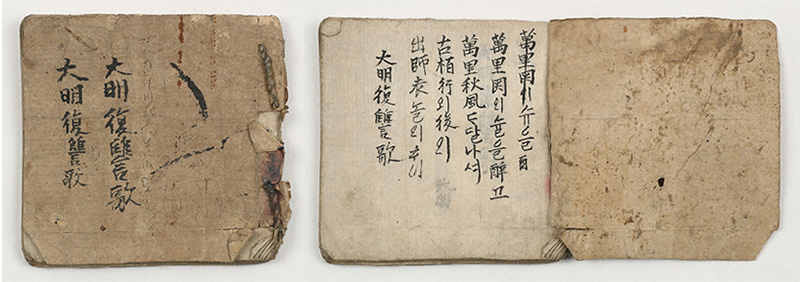 Daemyeongboksuga / Year of Mujin (戊辰, 1929) Johongchan (趙洪儧) / 14.8×10.4㎝
The original author is Jo Woo-gak (趙宇慤), and the date of creation is 1824 (the 24 year of King Sunjo’s rule). It is presumed that he built Manrigwan in Yeongcheon, Gyeongsangbuk-do, where he studied and taught students, and wrote this piece. He grieves over the Qing's destruction of the Ming Dynasty, and mourns for the disgrace of the country's shame during Byeongjahoran and the nation’s inability to pay back. In addition, he criticizes Choi Myung-gil and others for insisting on reinforcement and sings about taking revenge on the Qing dynasty by mobilizing loyalists from China and Korea.
Daemyeongboksuga / Year of Mujin (戊辰, 1929) Johongchan (趙洪儧) / 14.8×10.4㎝
The original author is Jo Woo-gak (趙宇慤), and the date of creation is 1824 (the 24 year of King Sunjo’s rule). It is presumed that he built Manrigwan in Yeongcheon, Gyeongsangbuk-do, where he studied and taught students, and wrote this piece. He grieves over the Qing's destruction of the Ming Dynasty, and mourns for the disgrace of the country's shame during Byeongjahoran and the nation’s inability to pay back. In addition, he criticizes Choi Myung-gil and others for insisting on reinforcement and sings about taking revenge on the Qing dynasty by mobilizing loyalists from China and Korea.
Daemyeongboksuga
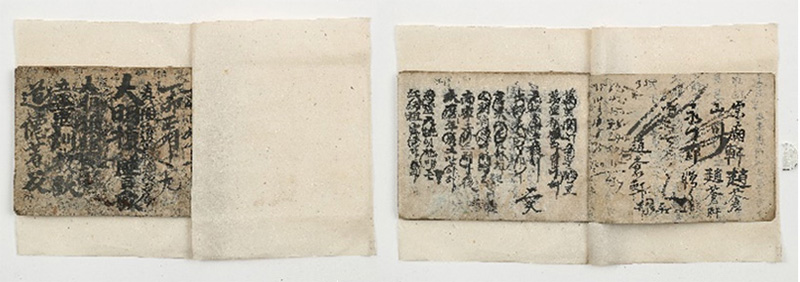 Daemyeongboksuga / Early 1900’s / 14.0×19.9㎝
It is the transcribed copy of the original piece written by Cho Wu-gak (趙宇慤) in 1824 (the 24th year of King Sunjo’s rule). He pledges to take revenge on the Qing Dynasty for the Ming Dynasty, mourns for the disgrace of the country's shame during Byeongjahoran, and vows to take revenge. Chinese words were written in Chinese characters instead of Korean alphabet, Hangeul.
Daemyeongboksuga / Early 1900’s / 14.0×19.9㎝
It is the transcribed copy of the original piece written by Cho Wu-gak (趙宇慤) in 1824 (the 24th year of King Sunjo’s rule). He pledges to take revenge on the Qing Dynasty for the Ming Dynasty, mourns for the disgrace of the country's shame during Byeongjahoran, and vows to take revenge. Chinese words were written in Chinese characters instead of Korean alphabet, Hangeul.
Dosanbyeolgok
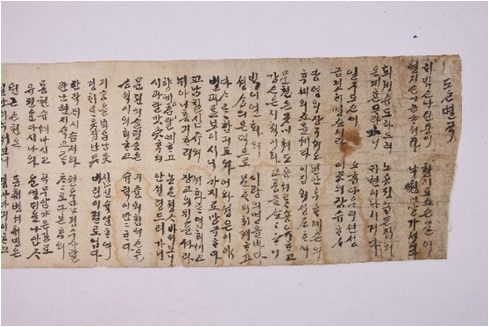 Dosanbyeolgok / 1911 / 16.5×86.5㎝
It is the transcribed version of the lyrics written by Cho Sung-sin (趙星臣, 1765 to 1835) during the late Joseon dynasty. Recalling his participation in the state exam of Byeolgwa (別科) during the memorial service held at Dosan Seowon in 1792, he talks about the scenery around Seowon and virtues and accomplishments of Yi Hwang. At the end of the piece, there is a record that the it is transcribed in March of the year of Sinhae and delivered to Jongmae (從妹).
Dosanbyeolgok / 1911 / 16.5×86.5㎝
It is the transcribed version of the lyrics written by Cho Sung-sin (趙星臣, 1765 to 1835) during the late Joseon dynasty. Recalling his participation in the state exam of Byeolgwa (別科) during the memorial service held at Dosan Seowon in 1792, he talks about the scenery around Seowon and virtues and accomplishments of Yi Hwang. At the end of the piece, there is a record that the it is transcribed in March of the year of Sinhae and delivered to Jongmae (從妹).
Byeoljiga
 Byeoljiga / Late 1800’s / 21.2×1076.0㎝
There is the transcription date as “MujinwonwolSipchilil (The seventeenth day of the first month of year of Mujin).”
Byeoljiga / Late 1800’s / 21.2×1076.0㎝
There is the transcription date as “MujinwonwolSipchilil (The seventeenth day of the first month of year of Mujin).”
Bukjeongga
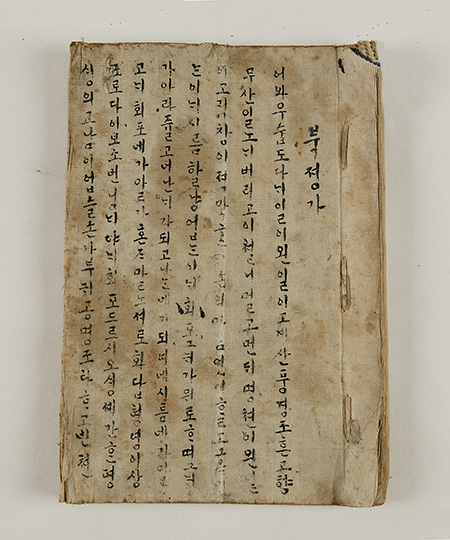 Bukjeongga / After 1886 / 28.3×19.5㎝
It is the transcribed copy of the exile piece written by Yi Jung-eon in 1886. It is along piece to reveal the troubled reality through the exile of a nobleman at the end of the Joseon dynasty. The overall structure consists of the introduction, body, and conclusion. In the introduction, he describes his lamentation over the exile and his intention to resign everything. In the body, he describes his background history, that he grew up in the Churo-oriented large family in Yeongnam, the futility of fame and wealth, the exile process, the injustice of such exile, and lamentation over his situation. Especially, he explains in details pains from an illness, hardships caused from insufficient allowance, and disgrace from the fall in his social position. In the conclusion, he regrets his life where he never compromised with the world and decides to live within his own capacity.
Bukjeongga / After 1886 / 28.3×19.5㎝
It is the transcribed copy of the exile piece written by Yi Jung-eon in 1886. It is along piece to reveal the troubled reality through the exile of a nobleman at the end of the Joseon dynasty. The overall structure consists of the introduction, body, and conclusion. In the introduction, he describes his lamentation over the exile and his intention to resign everything. In the body, he describes his background history, that he grew up in the Churo-oriented large family in Yeongnam, the futility of fame and wealth, the exile process, the injustice of such exile, and lamentation over his situation. Especially, he explains in details pains from an illness, hardships caused from insufficient allowance, and disgrace from the fall in his social position. In the conclusion, he regrets his life where he never compromised with the world and decides to live within his own capacity.
Bukchyeonga
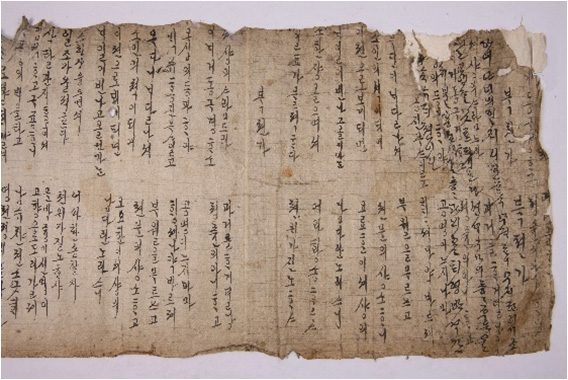 Bukchyeonga / Early 20th century / 26.0×400.0㎝
It is the transcribed copy of the exile piece written by Kim Jin-hyeong (金鎭衡) during the 4 year of King Cheoljong’s rule (1854) during the Joseon Dynasty. In 1853 (4 year of King Cheongjong’s rule), while he was in the position of Hongmungwan Gyori, he argued wrongdoings of Ijo Panseo Seo Gi-soon (徐箕淳), and was sent in exile to Myeongcheon, Hamgyong-do. This piece is about the journey from the exile to his return. It explains events about submission of Sangso and exile, the exile route from Seoulto Bukgwan (北關), the hospitality of the leader in Bukgwan, sightseeing of Chilbongsan Mountain (七峯山) and falling in love with the prostitute Gunsanwol (君山月), the route from Bukgwan to the exile site, Myeongcheon, receiving the news for his freedom right after arriving in Myeongcheon, returning to the hometown, and Gangho and Taepyeong. The piece is in the form of scroll and 3 different Buncheonga are included together.
Bukchyeonga / Early 20th century / 26.0×400.0㎝
It is the transcribed copy of the exile piece written by Kim Jin-hyeong (金鎭衡) during the 4 year of King Cheoljong’s rule (1854) during the Joseon Dynasty. In 1853 (4 year of King Cheongjong’s rule), while he was in the position of Hongmungwan Gyori, he argued wrongdoings of Ijo Panseo Seo Gi-soon (徐箕淳), and was sent in exile to Myeongcheon, Hamgyong-do. This piece is about the journey from the exile to his return. It explains events about submission of Sangso and exile, the exile route from Seoulto Bukgwan (北關), the hospitality of the leader in Bukgwan, sightseeing of Chilbongsan Mountain (七峯山) and falling in love with the prostitute Gunsanwol (君山月), the route from Bukgwan to the exile site, Myeongcheon, receiving the news for his freedom right after arriving in Myeongcheon, returning to the hometown, and Gangho and Taepyeong. The piece is in the form of scroll and 3 different Buncheonga are included together.
Songsyuga
 Songsyuga / Early 20th century / 20.9×222.2㎝
It is the transcribed copy of the lyrics written by a man wishing for his mother-in-law’s longevity during her 60th birthday in the first month of the year of Myeongo.
Songsyuga / Early 20th century / 20.9×222.2㎝
It is the transcribed copy of the lyrics written by a man wishing for his mother-in-law’s longevity during her 60th birthday in the first month of the year of Myeongo.
Chulsapyo
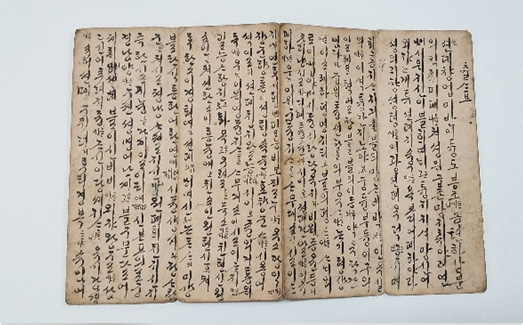 Chulsapyo / Early 20th century / 27.7×10.5㎝
It is the lyrics version of the statement that Zhuge Liang from the state of Shu Han submitted to the king when he was leaving to conquer the state of Cao Wei. Chulsapyo means “the statement to the king when raising the army.” Anyone not crying after reading Chulsapyo was not considered as loyal servants.
Chulsapyo / Early 20th century / 27.7×10.5㎝
It is the lyrics version of the statement that Zhuge Liang from the state of Shu Han submitted to the king when he was leaving to conquer the state of Cao Wei. Chulsapyo means “the statement to the king when raising the army.” Anyone not crying after reading Chulsapyo was not considered as loyal servants.
Haneuli Changjohasin (Created by the heaven)
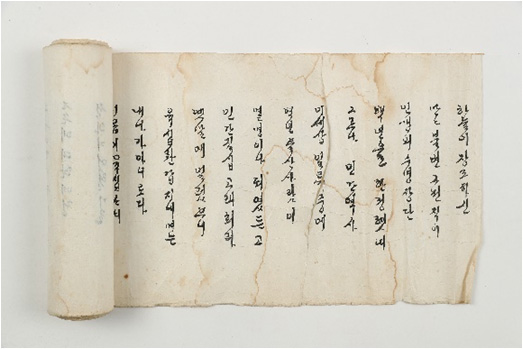 Haneuli Changjohasin (Created by the heaven) / 1970 (The year of Gyeongsul) / 24.1×93.5㎝
The writer wrote the piece at the age of 64. At the beginning, the writer states that she records Gasa as she is worried if she gets older and has no energy to write about descendants. She advises that her children including her son and wife acknowledge hardships and raise grandchildren well so that they can become talented individuals for the country.
Haneuli Changjohasin (Created by the heaven) / 1970 (The year of Gyeongsul) / 24.1×93.5㎝
The writer wrote the piece at the age of 64. At the beginning, the writer states that she records Gasa as she is worried if she gets older and has no energy to write about descendants. She advises that her children including her son and wife acknowledge hardships and raise grandchildren well so that they can become talented individuals for the country.
Haemongga
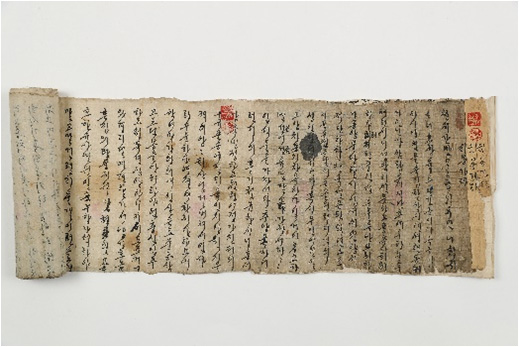 Haemongga / 1800’s / 19.8×369.2㎝
It is the transcribed copy of “Yulgokseonsaenghaemongga.” It includes enlightening contents based on the learning of the way (Dohak) to break foolishness. It is the piece that was widely sung among noble families in Yeongnam area. It appears to have been written before the 19th century based on the way it was transcribed.
Haemongga / 1800’s / 19.8×369.2㎝
It is the transcribed copy of “Yulgokseonsaenghaemongga.” It includes enlightening contents based on the learning of the way (Dohak) to break foolishness. It is the piece that was widely sung among noble families in Yeongnam area. It appears to have been written before the 19th century based on the way it was transcribed.












